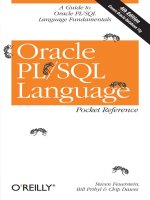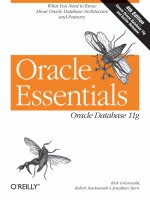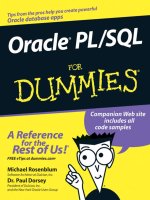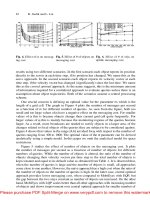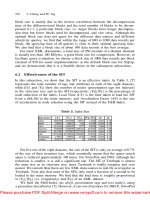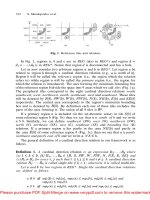Tài liệu Oracle NoSQL Database doc
Bạn đang xem bản rút gọn của tài liệu. Xem và tải ngay bản đầy đủ của tài liệu tại đây (1.7 MB, 12 trang )
An Oracle White Paper
September 2011
Oracle NoSQL Database
Oracle NoSQL Database
1
Introduction
NoSQL databases represent a recent evolution in enterprise application architecture,
continuing the evolution of the past twenty years. In the 1990’s, vertically integrated
applications gave way to client-server architectures, and more recently, client-server
architectures gave way to three-tier web application architectures. In parallel, the demands of
web-scale data analysis added map-reduce processing into the mix and data architects started
eschewing transactional consistency in exchange for incremental scalability and large-scale
distribution. The NoSQL movement emerged out of this second ecosystem.
NoSQL is often characterized by what it’s not – depending on whom you ask, it’s either not
only a SQL-based relational database management system or it’s simply not a SQL-based
RDBMS. While those definitions explain what NoSQL is not, they do little to explain what
NoSQL is. Consider the fundamentals that have guided data management for the past forty
years. RDBMS systems and large-scale data management have been characterized by the
transactional ACID properties of Atomicity, Consistency, Isolation, and Durability. In contrast,
NoSQL is sometimes characterized by the BASE acronym:
Basically Available: Use replication to reduce the likelihood of data unavailability and use
sharding, or partitioning the data among many different storage servers, to make any
remaining failures partial. The result is a system that is always available, even if subsets of
the data become unavailable for short periods of time.
Soft state: While ACID systems assume that data consistency is a hard requirement,
NoSQL systems allow data to be inconsistent and relegate designing around such
inconsistencies to application developers.
Eventually consistent: Although applications must deal with instantaneous consistency,
NoSQL systems ensure that at some future point in time the data assumes a consistent
state. In contrast to ACID systems that enforce consistency at transaction commit, NoSQL
guarantees consistency only at some undefined future time.
NoSQL emerged as companies, such as Amazon, Google, LinkedIn and Twitter struggled to
deal with unprecedented data and operation volumes under tight latency constraints. Analyzing
high-volume, real time data, such as web-site click streams, provides significant business
advantage by harnessing unstructured and semi-structured data sources to create more
business value. Traditional relational databases were not up to the task, so enterprises built
upon a decade of research on distributed hash tables (DHTs) and either conventional
relational database systems or embedded key/value stores, such as Oracle’s Berkeley DB, to
develop highly available, distributed key-value stores.
Oracle NoSQL Database
2
Although some of the early NoSQL solutions built their systems atop existing relational
database engines, they quickly realized that such systems were designed for SQL-based
access patterns and latency demands that are quite different from those of NoSQL systems,
so these same organizations began to develop brand new storage layers. In contrast, Oracle’s
Berkeley DB product line was the original key/value store; Oracle Berkeley DB Java Edition
has been in commercial use for over eight years. By using Oracle Berkeley DB Java Edition as
the underlying storage engine beneath a NoSQL system, Oracle brings enterprise robustness
and stability to the NoSQL landscape.
Furthermore, until recently, integrating
NoSQL solutions with an enterprise
application architecture required manual
integration and custom development;
Oracle’s NoSQL Database provides all
the desirable features of NoSQL solutions
necessary for seamless integration into
an enterprise application architecture.
Figure 1 shows a canonical acquire-
organize-analyze data cycle,
demonstrating how Oracle’s NoSQL
Database fits into such an ecosystem.
Oracle-provided adapters allow the
Oracle NoSQL Database to integrate with
a Hadoop MapReduce framework or with
the Oracle Database in-database
MapReduce, Data Mining, R-based
analytics, or whatever business needs
demand.
The Oracle NoSQL Database, with its “No Single Point of Failure” architecture is the right
solution when data access is “simple” in nature and application demands exceed the volume or
latency capability of traditional data management solutions. For example, click-stream data
from high volume web sites, high-throughput event processing, and social networking
communications all represent application domains that produce extraordinary volumes of
simple keyed data. Monitoring online retail behavior, accessing customer profiles, pulling up
appropriate customer ads and storing and forwarding real-time communication are examples
of domains requiring the ultimate in low-latency access. Highly distributed applications such as
real-time sensor aggregation and scalable authentication also represent domains well-suited to
Oracle NoSQL Database.
!"#$%&'( !)*+,-'(.&/*)%-'(
!
!
!
!
!!"#$%&'!()*+!
!!"#$%&'!
(", +!
!"#$%&'!
/012,!)3!
!!!
!
!
!!!
!"#$%&'!
45$6$7$!
!!"#$%&'!
)$7$8$9'!
"#$%&'!
)$7$!:;7'<#$70#!
=$600>!
=)?1!
:;@)3!
A$>B'6C%'!
",=!
:;@)3!
DBE!
:;@)3!
AF;F;<!
"3:!44!
?F<C#'!GH!!"#$%&'!/012,!)$7$8$9'!!F;7'<#$7'9!9'$I&'99&J!F;70!7K'!6$7$!
I$;$<'I';7!'%09J97'IL!
Oracle NoSQL Database
.3
Technical Overview
Oracle NoSQL Database leverages the Oracle Berkeley DB Java Edition High Availability storage
engine to provide distributed, highly-available key/value storage for large-volume, latency-sensitive
applications or web services. It can also provide fast, reliable, distributed storage to applications that
need to integrate with ETL processing.
Data Model
In its simplest form, Oracle NoSQL Database implements a map from user-defined keys (Strings) to
opaque data items. It records version numbers for key/data pairs, but maintains the single latest
version in the store. Applications need never worry about reconciling incompatible versions because
Oracle NoSQL Database uses single-master replication; the master node always has the most up-to-
date value for a given key, while read-only replicas might have slightly older versions. Applications can
use version numbers to ensure consistency for read-modify-write operations.
Oracle NoSQL Database hashes keys to provide good distribution over a collection of computers that
provide storage for the database. However, applications can take advantage of subkey capabilities to
achieve data locality. A key is the concatenation of a Major Key Path and a Minor Key Path, both of which
are specified by the application. All records sharing a Major Key Path are co-located to achieve data-
locality. Within a co-located collection of Major Key Paths, the full key, comprised of both the Major
and Minor Key Paths, provides fast, indexed lookup. For example, an application storing user profiles
might use the profile-name as a Major Key Path and then have several Minor Key Paths for different
components of that profile such as email address, name, phone number, etc. Because applications have
complete control over the composition and interpretation of keys, different Major Key Paths can have
entirely different Minor Key Path structures. Continuing our previous example, one might store user
profiles and application profiles in the same store and maintain different Minor Key Paths for each.
Prefix key compression makes storage of key groups efficient.
While many NoSQL databases state that they provide eventual consistency, Oracle NoSQL Database
provides several different consistency policies. At one end of the spectrum, applications can specify
absolute consistency, which guarantees that all reads return the most recently written value for a
designated key. At the other end of the spectrum, applications capable of tolerating inconsistent data
can specify weak consistency, allowing the database to return a value efficiently even if it is not entirely
up to date. In between these two extremes, applications can specify time-based consistency to constrain
how old a record might be or version-based consistency to support both atomicity for read-modify-write
operations and reads that are at least as recent as the
specified version. Figure 2 shows how the range of
flexible consistency policies enables developers to
easily create business solutions providing data
guarantees while meeting application latency and
scalability requirements.
Oracle NoSQL Database also provides a range of durability policies that specify what guarantees the
system makes after a crash. At one extreme, applications can request that write requests block until the
record has been written to stable storage on all copies. This has obvious performance and availability
implications, but ensures that if the application successfully writes data, that data will persist and can be
recovered even if all the copies become temporarily unavailable due to multiple simultaneous failures.
At the other extreme, applications can request that write operations return as soon as the system has
!"#$%&'()'*+&',% /&'01234'5-6-7-8&'!/&9"7"/"6:'2;&.6%$<'
!"#$%$&'#!()
*+,-,#&''$)
01=&' *"<&>?-8&@'
A&%8"1=>?-8&@' B781/$6&'
C-='%&-@'
86-/&'@-6-'
5-6-'"8'%&.&=6'-8'
1D'-'#"E&='F<&'
,;&%-F=#'1='G=1H='
1%'/-6&%'E&%8"1='
,;&%-F=#'1='6+&'
<186'%&.&=6'E&%8"1='
Oracle NoSQL Database
.4
recorded the existence of the write, even if the data is not persistent anywhere. Such a policy provides
the best write performance, but provides no durability guarantees. By specifying when the database
writes records to disk and what fraction of the copies of the record must be persistent (none, all, or a
simple majority), applications can enforce a wide range of durability policies.
API
Incorporating Oracle NoSQL Database into applications is straightforward. APIs for basic Create,
Read, Update and Delete (CRUD) operations and a collection of iterators are packaged in a single jar
file. Applications can use the APIs from one or more client processes that access a stand-alone Oracle
NoSQL Database server process, alleviating the need to set up multi-system configurations for initial
development and testing.
Create, Remove, Update, and Delete
Data create and update operations are provided by several put methods. The putIfAbsent method
implements creation while the putIfPresent method implements update. The put method does both,
adding a new key/value pair if the key is not currently present in the database or updating the value if
the key does exist. Updating a key/value pair generates a new version of the pair, so the API also
includes a conditional putIfVersion method that allows applications to implement consistent read-
modify-write semantics.
The delete and deleteIfVersion methods unconditionally and conditionally remove key/value pairs from
the database, respectively. Just as putIfVersion ensures read-modify-write semantics, deleteIfVersion
provides deletion of a specific version.
The get method retrieves items from the database.
The code sample below demonstrates the use of the various CRUD APIs. All code samples assume
that you have already opened an Oracle NoSQL Database, referenced by the variable store.
CRUD Examples
// Put a new key/value pair in the database, if key not already present.
Key key = Key.createKey("Katana");
String valString = "sword";
store.putIfAbsent(key, Value.createValue(valString.getBytes()));
// Read the value back from the database.
ValueVersion retValue = store.get(key);
// Update this item, only if the current version matches the version I read.
// In conjunction with the previous get, this implements a read-modify-write
String newvalString = "Really nice sword";
Value newval = Value.createValue(newvalString.getBytes());
store.putIfVersion(key, newval, retValue.getVersion());
// Finally, (unconditionally) delete this key/value pair from the database.
store.delete(key);
Oracle NoSQL Database
.5
Iteration
In addition to basic CRUD operations, Oracle NoSQL Database supports two types of iteration:
unordered iteration over records and ordered iteration within a Major Key set.
In the case of unordered iteration over the entire store, the result is not transactional; the iteration runs
at an isolation level of read-committed, which means that the result set will contain only key/value pairs
that have been persistently written to the database, but there are no guarantees of semantic consistency
across key/value pairs.
The API supports both individual key/value returns using several storeIterator methods and bulk
key/value returns within a Major Key Path via the various multiGetIterator methods. The example below
demonstrates iterating over an entire store, returning each key/value pair individually. Note that
although the iterator returns only a single key/value pair at a time, the storeIterator method takes a
second parameter of batchSize, indicating how many key/value pairs to fetch per network round trip.
This allows applications to simultaneously use network bandwidth efficiently, while maintaining the
simplicity of key-at-a-time access in the API.
Bulk Operation API
In addition to providing single-record operations, Oracle NoSQL Database supports the ability to
bundle a collection of operations together using the execute method, providing transactional semantics
across multiple updates on records with the same Major Key Path. For example, let’s assume that we
have the Major Key Path “Katana” from the previous example, with several different Minor Key
Paths, containing attributes of the Katana, such as length and year of construction. Imagine that we
discover that we have an incorrect length and year of construction currently in our store. We can
update multiple records atomically using a sequence of operations as shown below.
Unordered Iteration Example
// Create Iterator.
Iterator<KeyValueVersion> iter = store.storeIterator(Direction.UNORDERED, 100);
// Now, iterate over the store.
while (iter.hasNext()) {
KeyValueVersion keyVV = iter.next();
Value val = keyVV.getValue();
Key key = keyVV.getKey();
System.out.println(val.toString() + " " + key.toString() + "\n");
}
Oracle NoSQL Database
.6
Administration
Oracle NoSQL Database comes with an Administration Service, accessible from both a command line
interface and a web console. Using the service, administrators can configure a database instance, start
it, stop it, and monitor system performance, without manually editing configuration files, writing shell
scripts, or performing explicit database operations.
The Administration Service is itself a highly-available service, but consistent with the Oracle NoSQL
Database “No Single Point of Failure” philosophy, the ongoing operation of an installation is not
dependent upon the availability of the Administration Service. Thus, both the database and the
Administration Service remain available during configuration changes.
In addition to facilitating configuration changes, the Administration Service also collects and maintains
performance statistics and logs important system events, providing online monitoring and input to
performance tuning.
Example of Wrapping a Sequence of Operations in a Transaction
// Create a sequence of operations.
OperationFactory of = store.getOperationFactory();
List<Operation> opList = new ArrayList<Operation>();
// Create major and minor path components.
List<String> majorComponents = new ArrayList<String>();
List<String> minorLength = new ArrayList<String>();
List<String> minorYear = new ArrayList<String>();
majorComponents.add(“Katana”);
minorLength .add(“length”);
minorYear.add(“year”);
Key key1 = Key.createKey(majorComponents, minorLength);
Key key2 = Key.createKey(majorComponents, minorYear);
// Now put operations in an opList.
String lenVal = “37”;
String yearVal = “1454”;
opList.add(of.createPut(key1, Value.createValue(lenVal.getBytes())));
opList.add(of.createPut(key2, Value.createValue(yearVal.getBytes())));
// Now execute the operation list.
store.execute(opList);
Oracle NoSQL Database
.7
Architecture
We present the Oracle NoSQL Database architecture by following the execution of an operation
through the logical components of the system and then discussing how those components map to
actual hardware and software operation. We will create the key/value pair “Katana” and “sword”.
Figure 3 depicts the method invocation putIfAbsent(“Katana”, “sword”)
1
.
The application issues the putIfAbsent
method to the Client Driver (step 1).
The client driver hashes the key
“Katana” to select one of a fixed
number of partitions (step 2). The
number of partitions is fixed and set
by an administrator at system
configuration time and is chosen to be
significantly larger than the maximum
number of storage nodes expected in
the store. In this example, our store
contains 25 storage nodes, so we
might have configured the system to
have 25,000 partitions. Each partition
is assigned to a particular replication
group. The driver consults the
partition table (step 3) to map the
partition number to a replication group.
A replication group consists of some (configurable) number of replication nodes. Every replication group
consists of the same number of replication nodes. The number of replication nodes in a replication
group dictates the number of failures from which the system is resilient; a system with three nodes per
group can withstand two failures while continuing to service read requests. Its ability to withstand
failures on writes is based upon the configured durability policy. If the application does not require a
majority of participants to acknowledge a write, then the system can also withstand up to two failures
for writes. A five-node group can withstand up to four failures for reads and up to two failures for
writes, even if the application demands a durability policy requiring a majority of sites to acknowledge a
write operation.
Given a replication group, the Client Driver next consults the Replication Group State Table (RGST)
(step 4). For each replication group, the RGST contains information about each replication node
comprising the group (step 5). Based upon information in the RGST, such as the identity of the master
and the load on the various nodes in a replication group, the Client Driver selects the node to which to
send the request and forwards the request to the appropriate node (step 6). In this case, since we are
issuing a write operation, the request must go to the master node.
1
Although the API takes byte[] as Values, for convenience, we are showing the values as Strings.
!""#$%&'()*
+, *!/0* 12*"3405!678)49:;&4&)&<=*7>(?@A*
B2*/&?''()*C*D&7D9:;&4&)&<A*
/&?''()*
E&6#8*
F8"#$%&'()*
G?(3"*H4&48*
E&6#8*
I2*
J2*F8"#$%&'()*G?(3"*
!"#$% &'($% )$*("+*$% ,"*-%
FK1L)1* M&748?* NO* H,LB1*
FK1L)B* F8"#$%&* 1OO* H,LBB*
FK1L)I* F8"#$%&* 1O* H,LI*
N*
P#$8)4*-?$Q8?*
H4(?&K8*,(@87*
H,L1*
H,L1*
H,L1*
H,L1*
H,L1*
H,L1*
H,L1*
H,L1*
H,L1*
H,LB*
H,L1*
H,L1*
H,L1*
H,L1*
H,LI*
H,L1*
H,L1*
H,L1*
H,L1*
H,LJ*
H,L1*
H,L1*
H,L1*
H,L1*
H,LN*
R2*"3405!678)49:;&4&)&<=*7>(?@A*
S*
T$K3?8*IU*F8V3874*/?(%877$)K*
Oracle NoSQL Database
.8
The replication node then applies the operation. In the case of a putIfAbsent, if the key exists, the
operation has no effect and returns an error, indicating that the specified entry is already present in the
store. If the key does not exist, the replication node adds the key/value pair to the store and then
propagates the new key/value pair to the other nodes in the replication group (step 7).
Implementation
An Oracle NoSQL Database installation consists of two major pieces: a Client Driver and a collection of
Storage Nodes. As shown in Figure 3, the client driver implements the partition map and the RGST,
while storage nodes implement the replication nodes comprising replication groups. In this section,
we’ll take a closer look at each of these components.
Storage Nodes
A storage node (SN) is typically a physical machine with its own local persistent storage, either disk or
solid state, a CPU with one or more cores, memory, and an IP address. A system with more storage
nodes will provide greater aggregate throughput or storage capacity than one with fewer nodes, and
systems with a greater degree of replication in replication groups can provide decreased request latency
over installations with smaller degrees of replication.
A Storage Node Agent (SNA) runs on each storage node, monitoring that node’s behavior. The SNA
both receives configuration from and reports monitoring information to the Administration Service,
which interfaces to the Oracle NoSQL Database monitoring dashboard. The SNA collects operational
data from the storage node on an ongoing basis and then delivers it to the Administration Service
when asked for it.
A storage node serves one or more replication nodes. Each replication node belongs to a single
replication group. The nodes in a single replication group all serve the same data. Each group has a
designated master node that handles all data modification operations (create, update, and delete). The
other nodes are read-only replicas, but may assume the role of master should the master node fail. A
typical installation uses a replication factor of three in the replication groups, to ensure that the system
can survive at least two simultaneous faults and still continue to service read operations. Applications
requiring greater or lesser reliability can adjust this parameter accordingly.
Figure 4 shows an installation with 30
replication groups (0-29). Each replication
group has a replication factor of 3 (one master
and two replicas) spread across two data centers.
Note that we place two of the replication nodes
in the larger of the two data centers and the last
replication node in the smaller one. This sort of
arrangement might be appropriate for an
application that uses the larger data center for its
primary data access, maintaining the smaller data
center in case of catastrophic failure of the
primary data center. The 30 replication groups
are stored on 30 storage nodes, spread across
the two data centers.
!"#$%&'()#*'+(
!),-(
!),-(
!),-(
!),-(
!),-(
!),-(
!),-(
!),-(
!),-(
!),.(
!),-(
!),-(
!),-(
!),-(
!),/(
!),-(
!),-(
!),-(
!),-(
!),0(
!),-(
!),-(
!),-(
!),-(
!),1(
!),-(
!),-(
!),-(
!),-(
!),2(
3'4(!5%6'(
7%+8(9:;6<#;(
=(=(=(
=(=(=(
>'5?@6%<#;(&$#:5(A(
>'5?@6%<#;(&$#:5(.B(
=(=(=(
=(=(=(
=(=(=(
=(=(=(
>'5()#*'(
C%+"'$(
>'5()#*'(
>'5?@6%(
>'5()#*'(
>'5?@6%(
>'5()#*'(
C%+"'$(
>'5()#*'(
>'5?@6%(
>'5()#*'(
>'5?@6%(
D%"%(E';"'$(-(
D%"%(E';"'$(.(
F@&:$'(0G(H$68@"'6":$'(
I%$<<#;():JK'$+(
Oracle NoSQL Database
.9
Replication nodes support the Oracle NoSQL Database API via RMI calls from the client and obtain
data directly from or write data directly to the log-structured storage system, which provides
outstanding write performance, while maintaining index structures that provide low-latency read
performance as well. The Oracle NoSQL Database storage engine pioneered the use of log-structured
storage in key/value databases since its initial deployment in 2003 and has been proven in several
open-source NoSQL solutions, such as Dynamo, Voldemort, and GenieDB, as well as in Enterprise
deployments.
Oracle NoSQL Database uses replication to ensure data availability in the case of failure. Its single-
master architecture requires that writes are applied at the master node and then propagated to the
replicas. In the case of failure of the master node, the nodes in a replication group automatically hold a
reliable election (using the Paxos protocol), electing one of the remaining nodes to be the master. The
new master then assumes write responsibility.
Client Driver
The client driver is a Java jar file that exports the API to applications. In addition, the client driver
maintains a copy of the Topology and the Replication Group State Table (RGST). The Topology efficiently
maps keys to partitions and from partitions to replication groups. For each replication group, it
includes the host name of the storage node hosting each replication node in the group, the service
name associated with the replication nodes, and the data center in which each storage node resides.
The client then uses the RGST for two primary purposes: identifying the master node of a replication
group, so that it can send write requests to the master, and load balancing across all the nodes in a
replication group for reads. Since the RGST is a critical shared data structure, each client and
replication node maintains its own copy, thus avoiding any single point of failure. Both clients and
replication nodes run a RequestDispatcher that use the RGST to (re)direct write requests to the master
and read requests to the appropriate member of a replication group.
The Topology is loaded during client or replication node initialization and can subsequently be updated
by the administrator if there are Topology changes. The RGST is dynamic, requiring ongoing
maintenance. Each replication node runs a thread, called the Replication Node State Update thread, that is
responsible for ongoing maintenance of the RGST. The update thread, as well as the RequestDispatcher,
opportunistically collect information on remote replication nodes including the current state of the
node in its replication group, an indication of how up-to-date the node is, the time of the last
successful interaction with the node, the node’s trailing average response time, and the current length
of its outstanding request queue. In addition, the update thread maintains network connections and re-
establishes broken ones. This maintenance is done outside the RequestDispatcher’s request/response
cycle to minimize the impact of broken connections on latency.
Performance
We have experimented with various Oracle NoSQL Database configurations and present a few
performance results of the Yahoo! Cloud Serving Benchmark (YCSB), demonstrating how the system
scales with the number of nodes in the system. As with all performance measurements, your mileage
may vary.
We applied a constant YCSB load per storage node to configurations of varying sizes. Each storage
node was comprised of a 2.93ghz Westmere 5670 dual socket machine with 6 cores/socket and 24GB
of memory. Each machine had a 300GB local disk and ran RedHat 2.6.18-164.11.1.el5.crt1. At 300
Oracle NoSQL Database
.10
GB, the disk size is the scale-limiting resource on each node, dictating the overall configuration, so we
configured each node to hold 100M records, with an average key size of 13 bytes and data size of 1108
bytes.
The graph to the left shows the raw insert
performance of Oracle NoSQL Database for
configurations ranging from a single replication
group system with three nodes storing 100 million
records to a system with 32 replication groups on 96
nodes storing 2.1 billion records (the YCSB
benchmark is limited to a maximum of 2.1 billion
records). The graph shows both the throughput in
operations per second (blue line and left axis) and
the response time in milliseconds (red line and right
axis). Throughput of the system scales almost
linearly as the database size and number of
replication groups grows, with only a modest
increase in response time.
The second graph shows the throughput and
response time for a workload of 50% reads and 50%
updates. As the system grows in size (both data size
and number of replication groups), we see both the
update and read latency decline, while throughput
scales almost linearly, delivering the scalability
needed for today’s demanding applications.
Conclusion
Oracle’s NoSQL Database brings enterprise quality storage and performance to the highly-available,
widely distributed NoSQL environment. Its commercially proven, write-optimized storage system
delivers outstanding performance as well as robustness and reliability, and its “No Single Point of
Failure” design ensures that the system continues to run and data remain available after any failure.
Oracle NoSQL Database
September 2011
Oracle Corporation
World Headquarters
500 Oracle Parkway
Redwood Shores, CA 94065
U.S.A.
Worldwide Inquiries:
Phone: +1.650.506.7000
Fax: +1.650.506.7200
oracle.com
Copyright © 2011, Oracle and/or its affiliates. All rights reserved. This document is provided for information purposes only and the
contents hereof are subject to change without notice. This document is not warranted to be error-free, nor subject to any other
warranties or conditions, whether expressed orally or implied in law, including implied warranties and conditions of merchantability or
fitness for a particular purpose. We specifically disclaim any liability with respect to this document and no contractual obligations are
formed either directly or indirectly by this document. This document may not be reproduced or transmitted in any form or by any
means, electronic or mechanical, for any purpose, without our prior written permission.
Oracle and Java are registered trademarks of Oracle and/or its affiliates. Other names may be trademarks of their respective owners.
AMD, Opteron, the AMD logo, and the AMD Opteron logo are trademarks or registered trademarks of Advanced Micro Devices.
Intel and Intel Xeon are trademarks or registered trademarks of Intel Corporation. All SPARC trademarks are used under license
and are trademarks or registered trademarks of SPARC International, Inc. UNIX is a registered trademark licensed through X/Open
Company, Ltd. 1010



